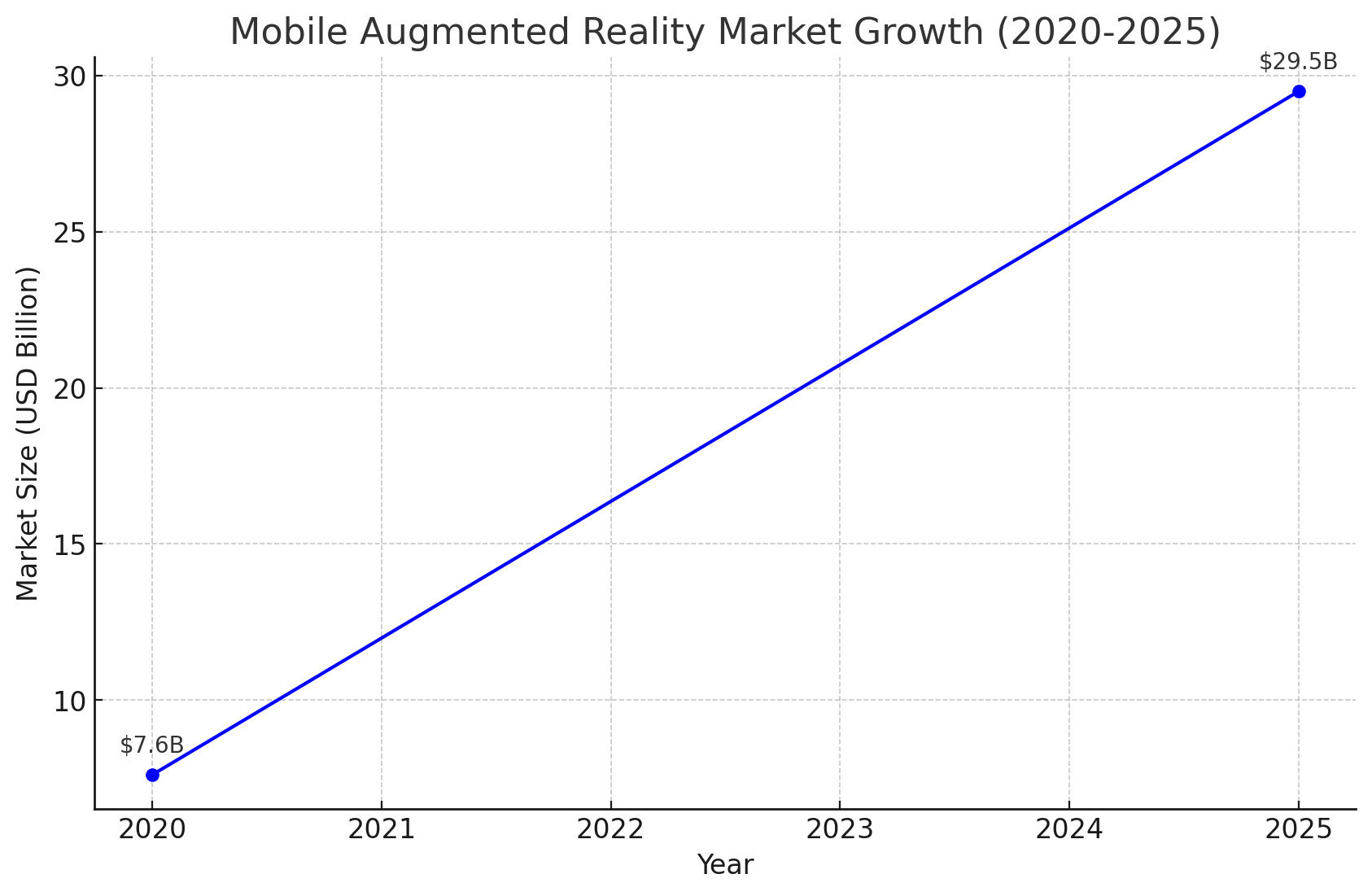Future of Augmented Reality in Mobile Apps
Introduction
Overview of Augmented Reality (AR)
AR is a particular type of computer-generated reality. Beyond that, it is also a technology that allows digital information to be superimposed on a real environment with the help of a smartphone or a similar device. AR is really a mobile technology. It audio-visual, and provides physical sensations to interact with the real world. Therefore, it opens up the possibility of creating a blended environment in the real world and the virtual world. This way, a person gets to experience something that is not available in the real world.
Importance of AR in Today's Mobile Ecosystem
AR is essential in improving the experiences of the users in various sectors such as gaming, retail, health, and education among others. As the statistics show, it is becoming increasingly popular: more than 83 million users in the United States use AR every month. According to MarketsandMarkets, the Mobile AR market is expected to grow from USD 7.6 billion in 2020 to USD 29.5 billion by 2025, with a CAGR of 31.1%, highlighting its increasing importance for businesses.

Engaging an AR app development company can assist in leveraging this technology for new-generation mobile applications. If you are interested in utilizing AR in your company, hiring an augmented reality app development company may be what is required to design custom mobile applications.
This blog focuses on the future of AR in mobile apps, and the current state of AR, trends, and possibilities to revolutionize businesses for tech entrepreneurs, business executives, and app developers.
Present Status of Augmented Reality in Mobile Applications
Top AR Apps in 2024
Some of the most innovative AR apps are as follows. Some of the examples include Pokémon GO which has been in the market since 2016 and IKEA Place that gives the user a realistic feel of how furniture will look like in his or her house. Snapchat’s AR lenses are also still in use, as millions of users put on AR filters every day.
Adoption Across Industries
AR is gradually being implemented across the different fields. For example in retail, IKEA and Sephora use AR for virtual fitting and product placement in the home. Some of the healthcare applications include AccuVein where the application of AR assists the healthcare professionals to locate veins more accurately. AR is also being used in the construction industry for activities such as planning and training of safety measures.

Below is the Market Map of Augmented Reality (AR) till 2024 based on the key markets: This chart depicts the market value of AR in gaming, the healthcare market and in retail. These industries constitute major fields through which the AR technology is exerting a large influence in the marketplace and in development.
AR in Consumer vs. Enterprise Apps
The consumer apps are mostly oriented towards the fun and ease, for instance, games and shopping, whereas the enterprise applications are aimed at improving the performance. For example, AR is applied in enterprises for telepresence, equipment servicing, and training, giving instruments that enhance productivity and minimize mistakes.
New Directions in AR for Mobile Applications
AI and AR Integration:
AI and AR integration is another force that is pushing the next generation of mobility. AI improves AR because it provides real-time identification of objects and predictive analysis, which makes the applications smarter. This integration is particularly helpful in industries such as healthcare since AR can be used in diagnosing a patient and in developing a treatment plan.
Wearable AR Devices and Their Impact on Mobile Apps
Wearable AR devices like AR glasses are expected to change the face of mobile applications in the near future. These devices enable the AR experiences to be done without the need for hands, which is very useful in areas such as healthcare and industries. As these technologies advance, mobile applications will have to integrate themselves into support multiple devices.
5G and Cloud Computing Enhancing AR Experiences
The two technologies that are expected to transform AR are 5G technology and cloud computing since they will offer higher data rates. These developments would help in creating better and realistic AR applications, especially in real-time applications like gaming or virtual events. Offloading of processing tasks will also be done through the cloud to enhance the complexity of AR experiences without the need to lower the performance.
Construction Augmented Reality Apps
AR is therefore widely adopted in the construction industry for better and precise designs, safety measures and management of the construction projects. Mobile applications that allow construction plans to be displayed in the real environment in 3D manner minimize errors, improve communication, and decrease time to complete the project. This is the application of AR that is becoming crucial in the current construction projects.
How AR/VR Helps Businesses
Enhanced Customer Engagement
Augmented Reality (AR) increases the attractiveness of a product and customer satisfaction by providing unique experiences. For example, AR apps such as the IKEA Place that enables customers to see products in their homes without purchasing them cuts down on returns and increases sales.
Improved Training and Simulation
AR also transforms corporate training through detailed training models that enhance employee preparedness for work, especially in health and manufacturing sectors. This makes it possible for the employees to rehearse on risky operations until they are accomplished, thus increasing efficiency and readiness.
Streamlined Operations and Workflow
In operations, AR improves efficiency by allowing virtual prototyping, real-time data visualization, and remote working. These capabilities enable the businesses to minimize mistakes, improve on their operations and make the right decisions within the shortest time possible.
Competitive Advantage
Implementing AR provides the businesses with competitive advantage since it places the company as an innovator and creates new sources of revenue. Businesses that use AR are positioned in the market as leaders with the latest and exciting experiences that customers can’t help but interact with.
The Place of AR in Future Mobile Application Development
AR's Potential to Transform User Engagement
It is believed that with the help of AR, users’ experience in interacting with mobile applications will be shifted to a completely new level and will become more personalized and contextual. Thus, as AR technology develops, applications will be able to deliver contextual and personalized information and interaction enhancing the experience of a user.
The Future Landscape of AR Development Services
Since there is an ever-growing market for AR apps, there will always be a need for AR app development services. The companies that will be in a position to offer these services will be the ones that are in the development of AR since they will assist the businesses to adopt the AR and keep on with the competition.
Conclusion
Augmented Reality (AR) is quickly becoming one of the most popular trends in the mobile application market, allowing businesses to open new opportunities for increasing the level of customer participation and efficiency. It is for this reason that as the AR technology advances, it opens up a number of opportunities for various sectors such as gaming, retail, healthcare, construction among others. Because of the integration of AI technology, wearable devices, and 5G, the scope of AR is increasing, which is why it is the best time to invest in AR. Implementing AR today means that businesses will be ready for the digital tomorrow, providing users with engaging experiences that will lead to growth.
FAQs
What is Augmented Reality (AR)?
Augmented Reality (AR) is a technology that overlays digital content, such as images, sounds, and other sensory inputs, onto the real world, typically through mobile devices like smartphones or AR glasses.
How does AR differ from Virtual Reality (VR)?
AR overlays digital elements onto the real world, enhancing the user’s environment, while VR creates a completely immersive digital environment, disconnecting the user from the real world.
What is the difference between consumer and enterprise AR applications?
Consumer AR apps focus on entertainment and convenience, such as gaming and shopping, while enterprise AR apps are designed to improve productivity, training, and operational efficiency in businesses.
In which industries is AR commonly used?
AR is used in various industries, including gaming, retail, healthcare, construction, education, and manufacturing.
What are the benefits of integrating AR into mobile applications?
AR enhances user engagement, improves training and simulation, streamlines operations, and provides businesses with a competitive advantage by offering unique experiences.




















